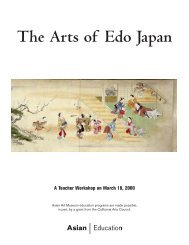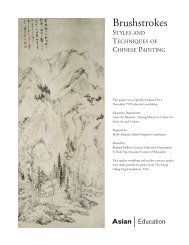Sacred Arts of Tibet (.pdf) - Asian Art Museum | Education
Sacred Arts of Tibet (.pdf) - Asian Art Museum | Education
Sacred Arts of Tibet (.pdf) - Asian Art Museum | Education
You also want an ePaper? Increase the reach of your titles
YUMPU automatically turns print PDFs into web optimized ePapers that Google loves.
HISTORY<br />
<strong>Sacred</strong> <strong><strong>Art</strong>s</strong> <strong>of</strong> <strong>Tibet</strong><br />
The Age <strong>of</strong> Kings: The "First Transmission" <strong>of</strong> Buddhism to <strong>Tibet</strong><br />
(approximately. 400 BCE- 850 CE)<br />
According to traditional accounts, <strong>Tibet</strong> began its movement toward nationhood in 400 BCE, when the<br />
first king descended a ladder <strong>of</strong> colored rope (a rainbow bridge between heaven and earth) to the top <strong>of</strong> a<br />
mountain in the Yarlung Valley. The earliest dated foreign reference to <strong>Tibet</strong> is found in second-century<br />
Chinese annals referring to <strong>Tibet</strong>an armies raiding the Chinese frontier regions. It is not until the early<br />
seventh century that any significant information is recorded. At this time <strong>Tibet</strong>ans thrust themselves into<br />
Chinese attention as a powerful military force crossing their borders and establishing influence all the way<br />
into the Chinese heartland. Tang Dynasty documents describe the <strong>Tibet</strong>ans as fierce, powerful warriors.<br />
There is genuine admiration expressed for <strong>Tibet</strong>an horses, armor, tactics, and courageous, single-minded<br />
determination. The <strong>Tibet</strong>ans are also described as having great castles, walled towns, and as being skilled<br />
in metalworking, art, and rhetoric.<br />
Songtsen Gampo (618-650), the First King <strong>of</strong> a Unified <strong>Tibet</strong><br />
In 627, the <strong>Tibet</strong>an Emperor, Songtsen Gampo (618-650), with the backing <strong>of</strong> other powerful clans,<br />
arose as the first historical ruler <strong>of</strong> a unified <strong>Tibet</strong>. He was a unifying figure also because he was believed<br />
to be descended from a line <strong>of</strong> divine kings from <strong>Tibet</strong>’s mythical past. His rule is the first subject dealt<br />
with in clear historical terms by the earliest <strong>Tibet</strong>an documents. Emperor Songtsen Gampo quickly finished<br />
the work <strong>of</strong> putting together the empire that had been started by his father. After bringing eastern<br />
<strong>Tibet</strong> under his control, he immediately conquered Koko Nor to the north, and from there swept down<br />
into the heartland <strong>of</strong> China. Upon receiving an <strong>of</strong>ficial homage from a Chinese ambassador, Emperor<br />
Songtsen Gampo demanded the daughter <strong>of</strong> the Tang Emperor in recognition <strong>of</strong> his position. This sort <strong>of</strong><br />
royal marriage was a form <strong>of</strong> diplomacy and a method for establishing close relations between two courts.<br />
In response to what he must have regarded as a lack <strong>of</strong> Chinese enthusiasm, he led his forces all the way<br />
to the Chinese capital. The Chinese quickly produced the desired princess, Lady Wen Cheng.<br />
Empress Wen Cheng and Empress Bhrikuti Help Establish Buddhism in <strong>Tibet</strong><br />
Lady Wen Cheng (see Slide 2) was an ardent Buddhist; she used her talents and influence to help her<br />
royal husband to spread Buddhism to every corner <strong>of</strong> the <strong>Tibet</strong>an Empire. She brought with her a famous<br />
statue <strong>of</strong> Shakyamuni Buddha, the Jo Rinpoche. This is still the most venerate object <strong>of</strong> worship in <strong>Tibet</strong>,<br />
housed in the Jokhang in Lhasa, the ultimate pilgrimage site for <strong>Tibet</strong>an Buddhists. Aside from bringing<br />
Buddhist sacred art and devotional objects, she also sent to China for paper makers, brewers, and silkworms.<br />
The <strong>Tibet</strong>an customs <strong>of</strong> drinking tea and wearing silk brocades date from her time. Under her<br />
insistence, Emperor Songtsen Gampo forbade certain <strong>Tibet</strong>an practices, such as decorating faces with red<br />
pigment and wrestling with bears, a custom she characterized as barbarous.<br />
The Emperor Songtsen Gampo’s first wife was also the daughter <strong>of</strong> a great king, Amshuvarman, King <strong>of</strong><br />
Nepal. Her name was Bhrikuti, and she did much to propagate Buddhism in <strong>Tibet</strong>. She brought with her<br />
a sandalwood statue <strong>of</strong> the goddess Tara, one <strong>of</strong> the most popular deities in the Buddhist pantheon. For<br />
their role in bringing Buddhism to <strong>Tibet</strong>, Emperor Songtsen Gampo’s two principle wives, the Chinese<br />
and Nepalese princesses, are regarded in <strong>Tibet</strong> as emanations <strong>of</strong> the two most influential Taras, White<br />
12<br />
<strong>Asian</strong> <strong>Art</strong> <strong>Museum</strong>
















